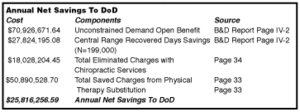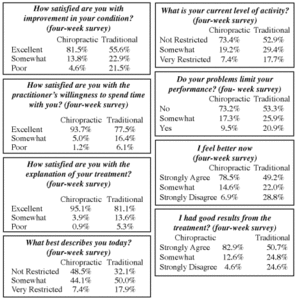When the Department of Defense began designing the CHCDP, they invited representation from five chiropractic organizations: Ronald Evans, DC - Foundation for Chiropractic Education and Research; The National Defense Authorization Act for Fiscal Year 1995 mandated that Congress undertake a demonstration project to determine the cost effectiveness of adding chiropractic care in the military. That project became the Chiropractic Health Care Demonstration Program (CHCDP). The Department of Defense (DoD) directed the military to begin a three-year demonstration project (Aug. 1995 to Aug. 1998) at 10 military treatment facilities, with three other military sites not offering chiropractic used to compare outcome measures. The program was later extended for two more years, and three other military facilities were added. Congress has now terminated the CHCDP, but required the DoD to maintain, as a minimum, the current level and scope of chiropractic care services at the 13 authorized sites until at least September 30, 2000.
When the Department of Defense (DOD) began designing the CHCDP, they invited representation from five chiropractic organizations: Ronald Evans, DC - Foundation for Chiropractic Education and Research; Peter Ferguson, DC - Federation of Chiropractic Licensing Boards; George Goodman, DC - Association of Chiropractic Colleges; Rick McMichael, DC - Congress of Chiropractic State Associations; and Reed Phillips, DC, PhD - Council on Chiropractic Education. These five chiropractors, along with Richard Beachman, DC, a clinical professor at Palmer College of Chiropractic West, became part of a 13-member oversight advisory committee for the project.
The CHCDP contractor, Birch & Davis, analyzed the CHCDP data and drafted a report, which was submitted to Congress by the DoD this February.
Among the conclusions by Birch & Davis:
- "Results of the survey data and referral patterns at each site suggest that traditional health care providers recognized the value of chiropractic care by their willingness to refer patients to chiropractic clinics.
Perceptions and attitudes about the acceptance of doctors of chiropractic and the appropriateness of spinal manipulation to treat certain medical conditions were judged to be favorable by traditional providers.
- "Provider attitudes toward doctors of chiropractic changed positively over time. The ability of doctors of chiropractic was judged more favorably after their integration. The study found that among traditional providers, the perceived appropriateness of chiropractic care and the perceived abilities of doctors of chiropractic increased over time.
- "Analysis of data collected from patients and providers indicates that chiropractic care was well received by the patient population. Overall, patients responded more favorably to chiropractic treatment than they did to traditional medical care."
- "Chiropractic service appears to have complemented and augmented traditional medical care. Enhanced readiness and the likely benefit of improved retention rates provide additional support for the advisability of integrating chiropractic care into the MHS.
- "The CHCDP did not result in any adverse medical care or patient perceptions that would contraindicate the feasibility of offering chiropractic care to DoD beneficiaries throughout the military health system."
The executive summary of the Birch/Davis report said it was "feasible to establish chiropractic services within the DoD," but advised against implemented chiropractic in the military because it would cost, by their estimate, $70.9 million.
Chiropractic Members of the Oversight Committee File Their Own Report to Congress
The chiropractic members of the oversight committee did not believe that they were afforded "sufficient opportunity for input during the course of the CHCDP, nor was their involvement sought in the analysis of CHCDP data or preparation of the draft final report as mandated by Congress." While the Birch/Davis report attests to the feasibility of providing chiropractic services in the military, the chiropractors of the oversight advisory committee clearly felt that the report did not "adequately reflect the advisability of including chiropractic services."
The DCs on the oversight committee thus felt compelled to release their own report and presented it to the Committee on Armed Services and the full Congress. That analysis was prepared with the assistance of Muse & Associates: Donald Muse, PhD; David Goldenberg, PhD; Gregory Portner; Steven Heath and Anne Marie Hummel. (Note: Be reminded that the report from the chiropractic advisors is the Muse report; the contractor's report is Birch/Davis.)
The most crucial disagreement between the two reports is the cost of implementing chiropractic care in the military health care services. The Muse report contends that those costs will be offset by inpatient care, emergency room services, physician services, physical therapy, other services, and recovered days; that these cost offsets will result in an "annual net savings to the DoD of $25.8 million." The table above from the Muse report tabulates those savings.
One focus of the Muse report was to re-analyze the "four week follow-up" survey from the CHCDP and present that material in table form. That feedback from the patients is illuminating and speaks for itself. A sampling of some of those tables can be found at the right of this page.
The Birch/Davis report asserts that "Active duty beneficiaries clearly have a strong demand for chiropractic services, and this demand is strictly increasing with age." Further, the Birch/Davis report indicates that back ailments are a major problem for the military. Using data contained in the Birch/Davis report, the Muse report calculated that approximately "51.5 patients per thousand, or about five percent of all personnel enrolled in the MHS, will be treated for lower back pain during a year."
Final Analysis
The assessment of the CHCDP by Birch/Davis was overwhelmingly positive for incorporating chiropractic health care services into the military.
Dynamic Chiropractic editorial staff members research, investigate and write articles for the publication on an ongoing basis. To contact the Editorial Department or submit an article of your own for consideration, email
.






